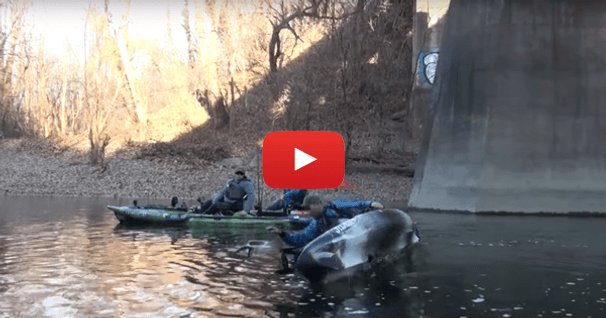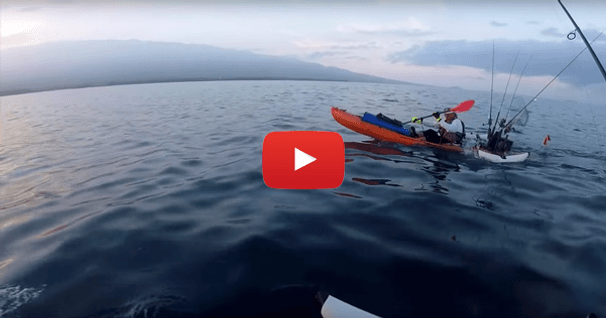Kayak Fishing Boat Stability Confidence
Hi, Jeff Little here. I'm the regional Pro Staff director for the Wilderness Systems Fishing Team. In this Paddling.net video, fellow pro staffer, Chris Gorsuch, and I are going to show you a couple drills that are going to really help you trust the stability of your kayak.
One of the biggest questions I get, when it comes to kayak, is stability and testing out the stability. And I've heard people talk about loose hips and being able to be in a boat. The best thing you can actually do is find a warm day, a little warmer than it is today, and get all of your gear off the boat. Take the boat out into an area and lean side to side, to see exactly where the tipping points are.
Today's kayaks are very, very stable, but you want to also know where the tipping point is and to find that, you can actually lean out, and you'll actually feel it and lean the other way until you get some confidence in what you're doing, confidence in the boat. And so, with all your gear out, you have no fear of losing anything. The warmer temperatures will allow you to be in the water if you do fall out of it, but you'll get the feel. When you have that confidence, you're really going to minimize the fear that you have about the stability of the craft.
Today's crafts are 29 to 32, even 33 inches wide. They're very stable, but you can still flip them. To help us with understanding the tipping points and the point of no return, when you get into a kayak and you want to find out where your balance points are, I'm here with Jeff Little to give us a demonstration or some pointers or some tips during classes that we've given on how to check the balance of the boat and so you get the feel for where it is. Today's water temperature is about 44 degrees. I'm going to suggest that maybe 70, 75, or warmer is a much better option.
In terms of boat stability and boat design, there's really two factors you're looking at. The primary thing that you're looking at is the width of the boat. Now, a boat like this Ride right here is designed for standing up and fishing out of the boat, super stable platform. A boat like the Tarpon here is also plenty stable enough, just not stable enough to stand up in. The thing that you give up with a boat that's wide like this is speed. Here's a fast boat that's plenty stable enough, and here's a slower boat that's super, super stable, designed for standing up.
The second feature you're going to look at is the hull design. The hull design on this Tarpon... overall, it's sort of a block shape, and it's not the three chined hull that you have here in the Ride. The Ride actually has two circular sort of shapes that dip down and then one keel in the middle, so that when you dip down on one side, you're actually using the center keel and that big bulbous shape on that one side; it gives you tremendous stability.
Now, I used to teach classes, kayak fishing classes, on the river here. One of the best things that I did for my students is I'd have them intentionally flip the boats. I'm going to do that first here with the Ride, and then with the Tarpon 140. You're going to see a head-on view of what that point of no return is.
Seated Stability Drill
First, get all of your gear out of the boats, because we are going to flip them. Then make sure you're in deep enough water so that when you flip, you're not going to bang your head on something. Second thing you do, get rid of that paddle. Third thing, you just lean and then pull back when you get scared, lean, pull back, lean. How far can I lean this? I'm going pretty far. There it is! *splash*... Now I know the point of no return. So you want to do this a couple times on each side.
Now, this isn't something I do all the time. Certainly, every time you get a new boat, one that you're not used to, you want to learn your tipping points. So I'm going to do it a couple times on each side. Now, let's try it on the other side, leaning. How far can I go? I almost have water coming over the side. Let me pull back, leaning. I'm actually trying to keep my torso up. Here it goes! *splash*
Stability Overkill?
Now, before I do this with the Tarpon 140, I'll give you my little commentary on the trend that you're seeing in fishing kayaks, is they're getting wider, bigger, and more stable, but there is such a thing as stability overkill. What you get with a wider boat, that's more stable, is the ability to stand up. If you're not going to stand up a lot, or if you value a boat that's fast, that's going to help you get to the fish faster, cover more water in a day, you don't need to go with a super wide and super slow boat. So this is a good example. As you'll see from a side view, it's a much more narrow boat. It's faster, but it is far from unstable... *splash* How far over did I go? Probably somewhere near a 45-degree angle, before it decided, okay, I'm going over. It's also a really good time to practice your wet re-entry into the boat.
Standing Stability Drill
So I've got this drill that I've used to help other kayak anglers who do not feel secure in the stability of their boat enough to stand up in the boat. In these boats that are wide enough that are really designed for it, if you're not standing in it and fishing and getting those advantages of seeing more of the area that you're fishing, you're really underutilizing your boat.
I'm here in a very shallow area. I'm actually going to pull out a little bit. The actual standing up part may be the biggest barrier to learning how to do this. So let's bypass that for now until you feel more secure standing up. Grab the sides of the boat and step into it. Now, you got three contact points with the boat. Bring your other foot in, and then stand up. I tell you to do it in shallow water, because if you do feel, "Oh, I don't like this," at least you can jump right out, and you're just in shallow water. You haven't fallen in the water that way. So, again, grab the sides. Get one foot in, then the other.
Now, what you're going to do is incrementally lift your feet on either side. I'm a little bit too shallow. I'm actually hitting bottom. You want to move out to where it's a little bit deeper. Your goal, your incremental steps, are to get where you feel secure enough that you can "flamingo". It usually takes people about ten minutes to get to the point where they do that. Most people won't lift their leg all the way up. So you're going to do it a little bit at a time, until you feel secure enough and you trust the boat. There. That's not going anywhere. It's stable.
Then you just start dancing in it. You know that it's secure. It's not going to get away from you. Really, getting over that initial hump of fearing it and thinking that you're going to go over, this is a great way to get over that.
This has been Jeff Little, with Wilderness Systems Kayaks, wishing you more time with your line in the water.
Related Articles
In this video, Chad is kayak fishing in the river in Happy Valley, Pennsylvania. He shares important…
As kayak anglers, you know you need to dress for immersion. But what do you do if you actually flip a…
Watch as a pair of kayak anglers experiences a sinking kayak several miles from shore. Thank goodness…
In this video, we're going to look at the best way to re-enter a sit-on-top kayak in the event that…



